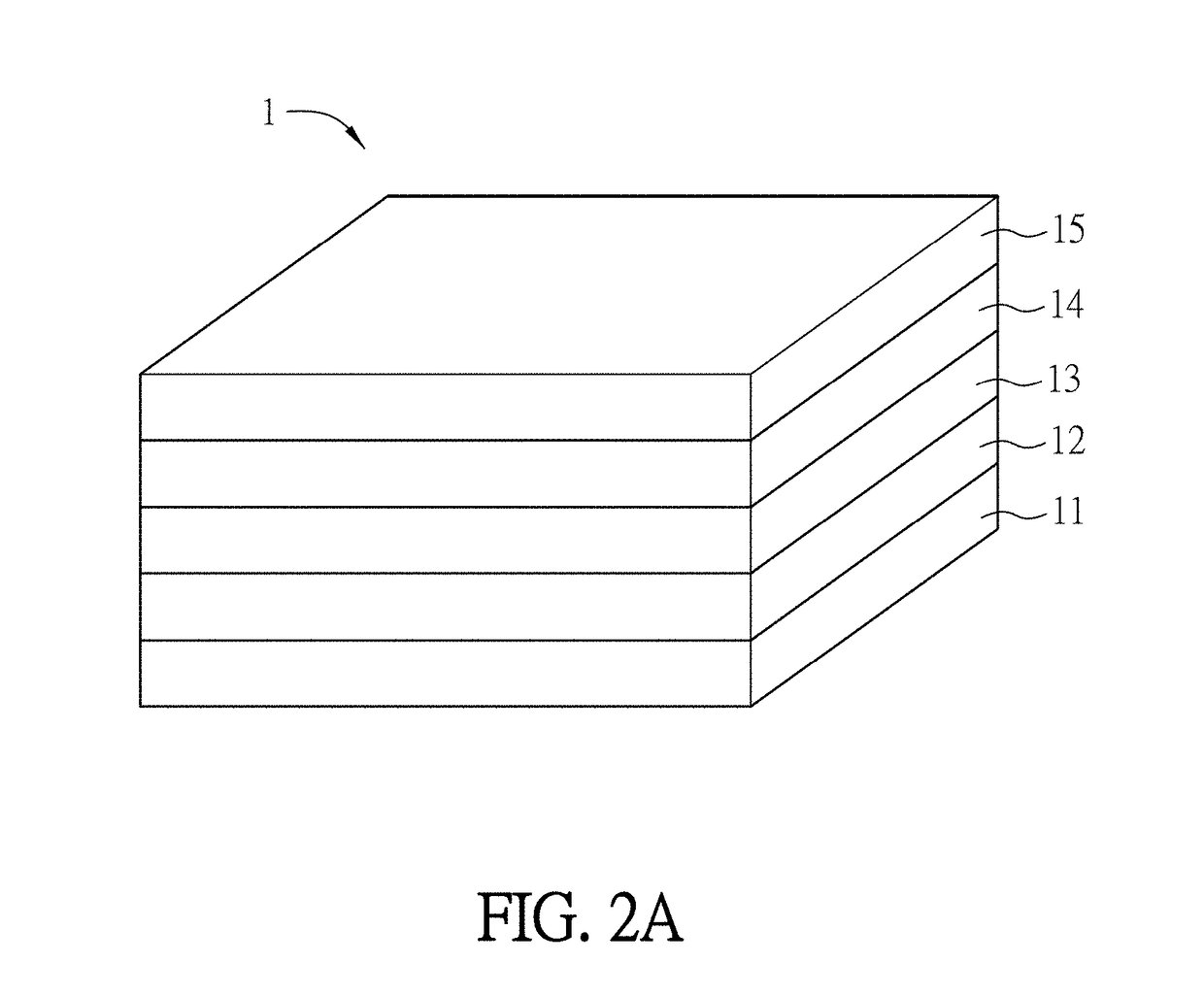Large-area perovskite film and perovskite solar cell or module and fabrication method thereof
a solar cell or module technology, applied in the direction of light-sensitive devices, solid-state devices, electrolytic capacitors, etc., can solve the problems of low active material cost, high short-circuit current and high open-circuit voltage of active layer containing thin perovskite film, and achieve high-quality large-area, uniform and high-quality large-area, and reduce manufacturing time and cost
- Summary
- Abstract
- Description
- Claims
- Application Information
AI Technical Summary
Benefits of technology
Problems solved by technology
Method used
Image
Examples
first embodiment
[0066]FIG. 4 is the current density vs. voltage curves of the perovskite solar module fabricated according to the invention. Referring to FIG. 4 in view of FIG. 2A, the conductive substrate 11 is an ITO / glass substrate with an area of 25 cm2, and the first carrier transporting layer 12 is made of PEDOT:PSS. CH3NH3I+PbI2 / DMF solution (30 wt %) is applied by slot die coating so as to form a film, and the film is immersed in an anti-solvent (thiophene) to form a perovskite film, thereby obtaining ITO / PEDOT:PSS / perovskite film. The perovskite film is used as the active layer 13. Then, the PCBM (30 nm) is deposited on ITO / PEDOT:PSS / perovskite to form the second carrier transporting layer 14. Finally, the silver is evaporated on the second carrier transporting layer 14 to form the electrode layer 15, thereby obtaining the perovskite solar module (6% efficiency). In addition, it is possible to adjust the concentration of the precursor solution, the coating speed, immersion conditions, and ...
second embodiment
[0068]FIG. 5 is the current density vs. voltage curves of the perovskite solar module fabricated according to the invention. Referring to FIG. 5 in view of FIG. 2A, the conductive substrate 11 is an ITO substrate, and the first carrier transporting layer 12 is made of PEDOT:PSS and deposited on the ITO substrate (100 cm2). Then, a film is formed on the ITO / PEDOT:PSS by spin coating (3000 rpm for 60 seconds) of the precursor solution (containing 0.35 M MAPbI3, 0.35 M MABr, and 0.4 M MACl in DMSO). Afterwards, at the last two seconds of spin coating of the precursor solution, the anti-solvent (iodobenzene) is applied on the spin-coated film. Then, the film is heated (annealed) at 100° C. for 30 seconds to obtain a uniform CH3NH3PbClxBryIz film. Herein, the CH3NH3PbClxBryIz film is used as the active layer 13. Then, C60 is evaporated on CH3NH3PbClxBryIz film to form the second carrier transporting layer 14. Finally, the aluminum is evaporated on the second carrier transporting layer 14...
third embodiment
[0069]FIG. 6 is the current density vs. voltage curves of the perovskite solar module fabricated according to the invention. Referring to FIG. 6 in view of FIG. 2A, the conductive substrate 11 is an ITO / PET substrate (100 cm2), and the first carrier transporting layer 12 is made of PEDOT:PSS and deposited on the ITO / PET substrate. Then, a film is formed on the ITO / PEDOT:PSS by spin coating (3000 rpm for 60 seconds) of the precursor solution (containing 0.35 M MAPbI3, 0.35 M MABr, and 0.4 M MACl in DMF). Afterwards, at the last two seconds of the spin coating the precursor solution, the anti-solvent (iodobenzene) is applied on the film. Then, the film is heated (annealed) at 100° C. for 30 seconds so as to obtain a uniform CH3NH3PbClxBryIz film. Herein, the CH3NH3PbClxBryIz film is used as the active layer 13. Then, the material C60 is evaporated on CH3NH3PbClxBryIz to form the second carrier transporting layer 14. Finally, the aluminum is evaporated on the second carrier transportin...
PUM
| Property | Measurement | Unit |
|---|---|---|
| Area | aaaaa | aaaaa |
| Area | aaaaa | aaaaa |
| Wavelength | aaaaa | aaaaa |
Abstract
Description
Claims
Application Information
 Login to View More
Login to View More - R&D
- Intellectual Property
- Life Sciences
- Materials
- Tech Scout
- Unparalleled Data Quality
- Higher Quality Content
- 60% Fewer Hallucinations
Browse by: Latest US Patents, China's latest patents, Technical Efficacy Thesaurus, Application Domain, Technology Topic, Popular Technical Reports.
© 2025 PatSnap. All rights reserved.Legal|Privacy policy|Modern Slavery Act Transparency Statement|Sitemap|About US| Contact US: help@patsnap.com



